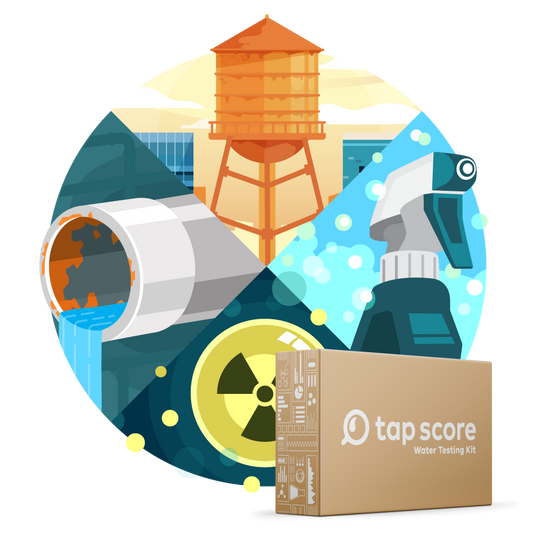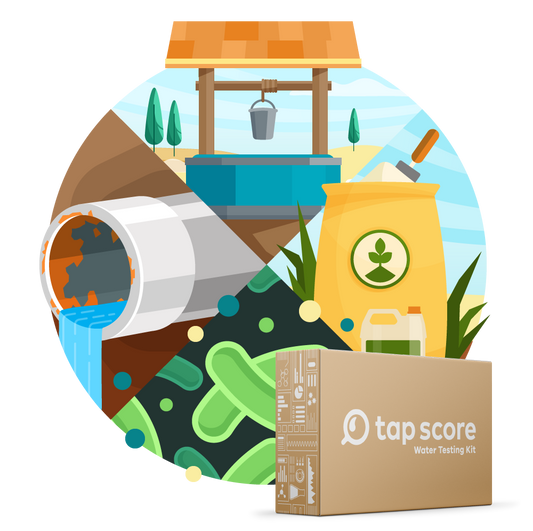
Quick Guide: Coliform Bacteria in Well Water
Our blog is written by real experts— not AI. Each guide is carefully reviewed and updated based on the latest research. Plus, with no affiliate links, you can count on unbiased insights you can trust.
Coliform bacteria in well water is one of the most common issues facing those with private or shared wells. In this quick guide, we delve into what you need to know about well contamination and coliform bacteria, like E. coli, and discuss the importance of well water testing and other ways to keep your drinking water safe.
Table of Contents:
- What Is Coliform?
- Health Effects of Coliform Bacteria
- How to Test for Coliform
- How to Treat Coliform
- Frequently Asked Questions
- What's the Takeaway?
What Is Coliform?
Coliform is a type of bacteria that lives naturally in the intestines of all healthy humans and warm-blooded animals; it is also common in soil, plants, and water.
Although almost all surface water sources (lakes, rivers, streams, reservoirs, etc.) contain some form of coliform, groundwater in a properly constructed and maintained well should generally be free of coliform bacteria.
How Does Coliform Bacteria Get into Well Water?
Coliform in well water is usually the result of nearby fecal contamination. The presence of coliform bacteria from human and animal waste in your well may be due to to broken septic systems, rainwater runoff of animal feces through the soil, or poorly constructed/damaged wells allowing surface contaminants to enter the groundwater directly. Bacteria may also enter the well when it is initially drilled or whenever maintenance is performed.

Is it Common to Have Coliform in Well Water?
Yes, it is fairly common to have coliform in well water. Multiple states have found that at least 1 in 4 wells tested positive for the presence of total coliform bacteria [1][2].
Definitions of Coliform
Coliform is a group of many different genera and species of bacteria that occur naturally in the environment and in the intestines of warm-blooded animals. “Coliform” is the name of the group of bacteria, while “coliforms” is used when talking about multiple bacteria genera or species within the group. There are three common levels of coliform bacteria that get discussed in the context of drinking water:
- Total Coliform: all coliform, including fecal coliform bacteria like E. coli and coliform from environmental sources like plants and soil
- Fecal Coliform: coliform from human and animal feces
- E. coli: a common species of fecal coliform with notable pathogenic strains (i.e. strain O157:H7)

What Are the Health Effects of Coliform in Well Water?
Most coliforms are not dangerous, but certain coliforms, like E. coli O157:H7, may cause adverse health effects, especially in vulnerable populations such as children and the elderly.
The health effects of coliform bacteria may include:
- Nausea
- Vomiting
- Fever
- Abdominal pain
- Diarrhea
Health effects from coliform bacteria are typically acute, meaning they occur suddenly and are often severe, unlike the chronic health effects typically associated with other common water contaminants that develop slowly and persist.
While it is usually possible to recover at home from infections caused by coliforms like E. coli, there is a risk that serious illness may occur, and medical attention is sometimes required.
How to Test for Coliform Bacteria in Well Water
Coliform tests are most accurately performed by a certified laboratory. Tap Score provides easy-to-use test kits designed to analyze a wide variety of contaminants, including coliform, without ever having to leave home.
State and local health agencies often have resources available for residents to test their well water for coliform and other contaminants if you reach out to them.
Or you can choose to test your well water with Tap Score, which does the legwork for you, and tests only with certified laboratories, relieving you of the need to find a laboratory near you.
Why Should I Test for Coliform in Well Water?
The EPA recommends well owners test their water for total coliform bacteria annually. A positive total coliform test is an indication that disease-causing bacteria like E. coli and other dangerous microorganisms may be present.
Not all coliforms cause disease, but pathogenic and harmless coliform bacteria can come from the same sources.
Which Type of Coliform Test Should I Use?
We recommend private well owners use a presence/absence (P/A) total coliform test. These tests determine whether coliform is present (at any concentration) or absent (not detected at all).
Any amount of coliform in your water is a potential problem and the same actions must be taken regardless of the amount, so an enumeration test, which tells you the quantity or concentration of coliform in your water, is not necessary.
If the case of a positive coliform test, the EPA recommends testing for E. coli; a P/A test is also sufficient for E. coli.
How Do I Detect Coliform in Well Water?
Not all coliforms have a smell, but certain coliform bacteria may produce a musty, earthy, or rotten egg smell in well water. It is possible to have coliforms in your well water with no noticeable change in the taste, odor, or color of the water. If certain disease-causing coliforms are present in your well water, you may experience negative gastrointestinal health effects.
Where Can I Get a Free Coliform Test?
Many state and local health departments offer free coliform testing for well owners and we encourage you to reach out to learn more. Information is usually posted on each health department’s website. This state-by-state guide to water labs can aid your search for local testing of coliform and other contaminants.
Note: Free tests might not give you a full picture of your well water’s quality as they may be missing other important contaminants such as nitrates and heavy metals, or local contaminants like pesticides and radionuclides.
Are There Acceptable Levels of Coliform Bacteria in Well Water?
According to the EPA's guidelines, there is no safe or acceptable level of coliform in well water. Any number of coliforms found in well water indicates that there is a pathway for potentially harmful bacteria to enter the well.
My Lab Report Only Says Present (P)?
If the lab report with your test results states "Present," it means a P/A (presence/absence) test was conducted. To determine the concentration of coliform in your water, you would need to request an enumeration test.
My Coliform Test Came Back Positive. Now What?
Before you treat: test again. It is very easy for well water samples to become cross-contaminated (see our sampling tips below). If the second test is still positive, the next step is usually shock chlorination (more on that later).
Afterward, consider installing a UV filter to keep your well disinfected without adding additional chemicals.
My Well Water Tested Positive for Coliform, but Not E. coli
E. coli is just one of the many types of coliform bacteria, so it is possible for your water to contain coliforms but not E. coli.
Sampling Tips
It’s very easy to contaminate a well water sample. Be sure to keep your hands and equipment clean so you don’t introduce any new contaminants into the equation while sampling.
Common ways coliform samples are contaminated:
- Dirty hands or equipment touch the sample and/or container
- Sampling site not properly disinfected or nearby source of contamination (i.e., septic tanks, animal waste, placing the sample cap on a dirty kitchen counter)
- Sample bottle not properly sealed/left exposed to air
- Rainfall during sampling introduces new contaminants
How to Get Rid of Coliform Bacteria in Well Water?
If your test results show you have coliform in your well water, shock chlorination is the first recommended course of action. This involves adding a high concentration of chlorine to your well, circulating it through the system, and then flushing to remove the chlorine once disinfection is complete.
Quick Guide to Shock Chlorination.
Once you have shocked your well, you may want to consider some additional treatments to prevent further buildup of coliform and other bacteria. Be sure to check that any treatment devices you purchase are certified to remove coliforms by the National Sanitation Foundation (NSF) if applicable, as indicated below.
Coliform in well water treatments include:
- UV Disinfection: Utilizes ultraviolet light to eliminate bacteria effectively without chemicals. (Certification: NSF/ANSI Standard 55)
- Chlorination Systems: Adds chlorine continuously to kill bacteria and prevent new growth. (Certification: NSF/ANSI Standards 60)
- Ozonation: Uses ozone gas to disinfect water.
- Reverse Osmosis (RO): Removes bacteria and impurities by forcing water through a membrane. (Certification: NSF/ANSI Standard 58)
Frequently Asked Questions:
Is it Safe to Shower in Water With Coliform?
It is generally considered safe for healthy adults to shower in water with coliform as long as they do not swallow any water. It is not recommended for young children or immunocompromised individuals to shower in water with coliform present.
How Often Should I Test for Coliform in Well Water?
The EPA recommends that you test your well for coliforms at least once a year.
You may choose to test more often if:
- You have had any well maintenance or changes to your well
- There have been natural disasters or extreme weather events, such as floods or hurricanes
- You detect an unusual taste or odor in your water
- Anyone in your household experiences unexplained health issues
Are DIY / At-home Test Kits Accurate for Coliform?
DIY at-home test kits for coliform are not consistently reliable. You should always have your water tested for coliform and other contaminants at a certified laboratory.
Is Coliform Bacteria in City Water Common?
Water from public utilities is tested and chlorinated frequently, making it unlikely for coliform to be found in city water. However, coliform can occasionally appear, usually as a result of some unforeseen event, like a hurricane or flood. If this happens, your utility will notify you and issue a boil water advisory to ensure safe water use.
What Else Should I Test My Well Water for?
In addition to coliform, you may want to test your well water for arsenic and other heavy metals, nitrate and nitrite, and minerals like calcium and magnesium.
With Tap Score’s Well Water Core Kits, you can test your well for these contaminants (including Total Coliform and E. coli) and many others without ever leaving home.
Ultimate Guide to Well Water Contaminants
What's the Takeaway?
- Not all coliforms are harmful, but both pathogenic and safe bacteria have the same sources—a positive coliform test means harmful bacteria may be present
- Well water should be tested for Coliform and E. coli at least annually
- Make sure your water is tested in a certified laboratory. Tap Score offers well water test kits that include coliform along with other common well water contaminants
- Shock chlorination is the first step to rid your well water of coliform. Other disinfection systems can be installed afterward
Read More
▾Water Testing Labs Near Me: State by State Guide
Shock Chlorination: How to Get Rid of Bacteria in Your Well Water
Sources and References
▾- Prevalence of Microbiological and Chemical Contaminants in Private Drinking Water Wells in Maryland, USA - PMC
- Total Coliform Bacteria, E. coli & PRIVATE WELLS
- Protect Your Home's Water | US EPA
- Revised Total Coliform Rule And Total Coliform Rule | US EPA
- NSF Standards for Water Treatment Systems
- Unsafe Water Notification Guidance - February 2023










